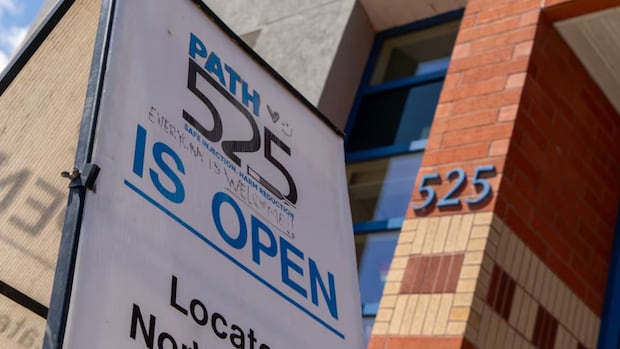B.C. advocate in Thunder Bay shares 30-year survival story as Ont. set to shut many safe consumption sites
;Resize=(620))
Guy Felicella says he was stuck in a cycle of addiction, homelessness and crime for more than 30 years, but accessing harm reduction support in Vancouver’s Downtown Eastside kept him alive long enough to reach recovery.
Felicella travelled to northwestern Ontario this week to share his story at the Thunder Bay District Health Unit’s (TBDHU) eighth annual harm reduction conference. His experience with addiction began at age 12.
“[I was] good at getting sober, never really good at staying sober,” Felicella said.
Vancouver and Thunder Bay are among the hardest hit in Canada by the opioid crisis.
More than 2,500 people died as a result of toxic drugs in Vancouver last year, at a rate of 56 per 100,000 population across the Vancouver Coastal Health authority.
In the same year, Thunder Bay saw the highest rate of opioid-related deaths in Ontario, at 69.5 per 100,000 population.
Ontario’s decision to shut down 10 supervised drug consumption sites is sparking backlash after documents revealed the closures go against the advice of the province’s own experts.
This summer, the Ontario government announced Thunder Bay’s only safe consumption site (SCS) and nine others in the province will close at the end of March under new rules, including that the sites can’t be within 200 metres of schools or child-care settings.
“Harm reduction does not enable people to use drugs. If you took it away, would people still use drugs? Yes. If you took away a hospital, would you get sick? Yes,” Felicella told over 200 delegates at Thursday’s conference in Thunder Bay.
“My hope is that the government of Ontario would reconsider,” he told CBC News. “If they’re going to close the site because it’s too close to a school, then open it in another area where people can access that service.”
‘Keeping people alive’
A number of services fall under harm reduction, including providing new needles, drug equipment and naloxone kits that are used to reverse the effects of an opioid overdose.
“Harm reduction means keeping people alive and providing them support at a time when they might not quite be ready for recovery or treatment,” said Kandace Belanger, who manages the street outreach, harm reduction and sexual health programs at the TBDHU.
“It’s a touch point with humans that care and can provide services to them.”
Amid a rise in opposition to harm reduction, she said, it’s important to educate people about what it means and what front-line workers are dealing with on a daily basis.
“Some of the conversations have really been about how to stand up for harm reduction in a climate that hasn’t been as receptive as of late, and how to work together and share resources and share ideas and be innovative,” she said of the conference’s focus.
Path 525 is the city’s only SCS. Ahead of its slated closures in the spring, it continues to provide a space for people to use drugs in the presence of health-care professionals, safe drug testing, and other on-site support.
“We have a lot of peer-led services,” Belanger said. “There are lots of organizations and services available that offer harm reduction, and we do partner across the city and work together to try to make the services as accessible as possible.”
Impact of shutting Path 525 down
Felicella said he’s used Insite, a SCS in the Downtown Eastside, countless times.
“If the supervised consumption site didn’t exist, I wouldn’t exist,” he said.
Insite marked its 20th anniversary last year after making history in 2003 as the first legalized SCS in North America.

“Addiction is a chronic relapsing condition,” Felicella said. “Unfortunately, when people relapse, that toxic drug supply [is] waiting for them and ends their life — and so you really have to have a harm reduction safety net under everything that we do to keep people going.”
Felicella fears Path 525’s closure will lead to more public drug use, safety issues, brain injuries and deaths.
“There’ll be more taxing on our health-care system and front-line workers, and then there will be also a huge cost to us as taxpayers as well to reduce the harms caused by all these complications,” he said.
Path 525 in Thunder Bay, Ont., is among 10 safe consumption sites that will have to close by March after the Ontario government banned such facilities within 200 metres of schools and child-care centres. Juanita Lawson, CEO of Norwest Community Health Centres, which operates the site, says she’s worried the closure will lead to more pressure on emergency health services and more overdose deaths.
Rilee Willianen, the City of Thunder Bay’s drug strategy specialist, says having conversations about harm reduction is increasingly important as these types of services are being rolled back.
“We engage in harm reduction almost every day. There’s things like wearing seat-belts, wearing a helmet, for example.
“There’s a lot of harm reduction efforts that people take value in, but harm reduction efforts with substance use — some people have a harder time believing in the value of those because of the stigmatization that comes with substance use.”
The five pillars of Thunder Bay’s drug strategy are prevention, treatment, harm reduction, enforcement and housing. A harm reduction working group meets monthly to discuss how the community can support that approach.
“I think it’s really important that we listen to the folks that are in recovery, and when they talk about how harm reduction efforts have really allowed them to come to the place that they are today,” Willianen said. “We need to listen to the experts.”
Available harm reduction services in Thunder Bay
- Safer drug use equipment: Free, sterile needles, pipes, and other safer drug use supplies are available at various local organizations with harm reduction distribution programs. Visit this map to find a program nearby.
- Naloxone: A life-saving medication that can reverse the effects of an opioid overdose, available through the Thunder Bay District Health Unit’s Harm Reduction Team, Superior Points 807-621-7861 or 807-621-7862 and at many pharmacies in Thunder Bay.
- Supervised Consumption Services (SCS): Available at NorWest Community Health Centres until further notice, Monday to Saturday from 10 a.m. to 6 p.m. Provides a safe space for individuals to use drugs under supervision, reducing the risk of overdose.
- Drug checking services: Offered at NorWest Community Health Centres, allowing people to quickly test substances for dangerous contaminants.
- Outreach harm reduction services: Delivering critical resources directly to people where they are, especially those who may not access traditional healthcare settings. Dial 211 to get connected.
- LifeguardConnect app: A digital tool that helps prevent overdoses by monitoring individuals who are using drugs alone. The app also sends out drug alerts when a toxic or unexpected substance is found in the community.
- Rapid Access to Addiction Medicine (RAAM) clinics: Providing quick and flexible access to addictions medicine. Dial 211 to get connected.
- Withdrawal management services: Available through the Balmoral Centre at 807-623-6515, offering a safe environment for medically managing withdrawal symptoms.




